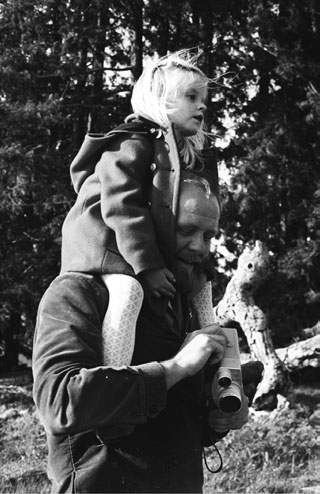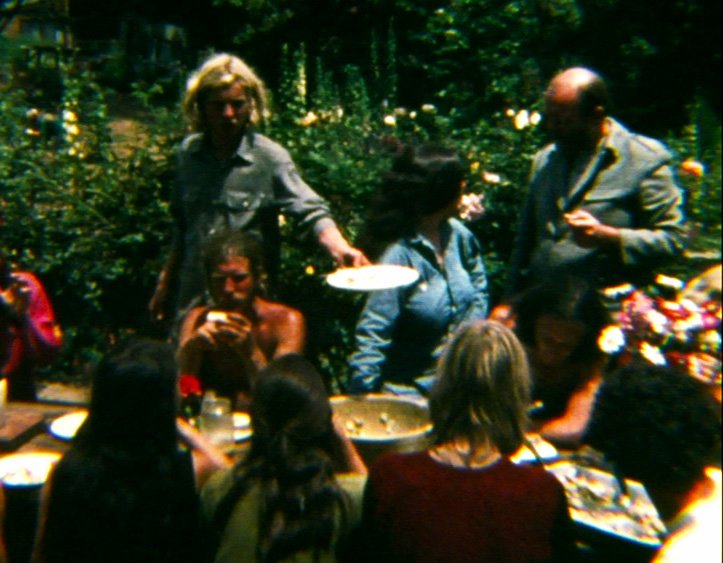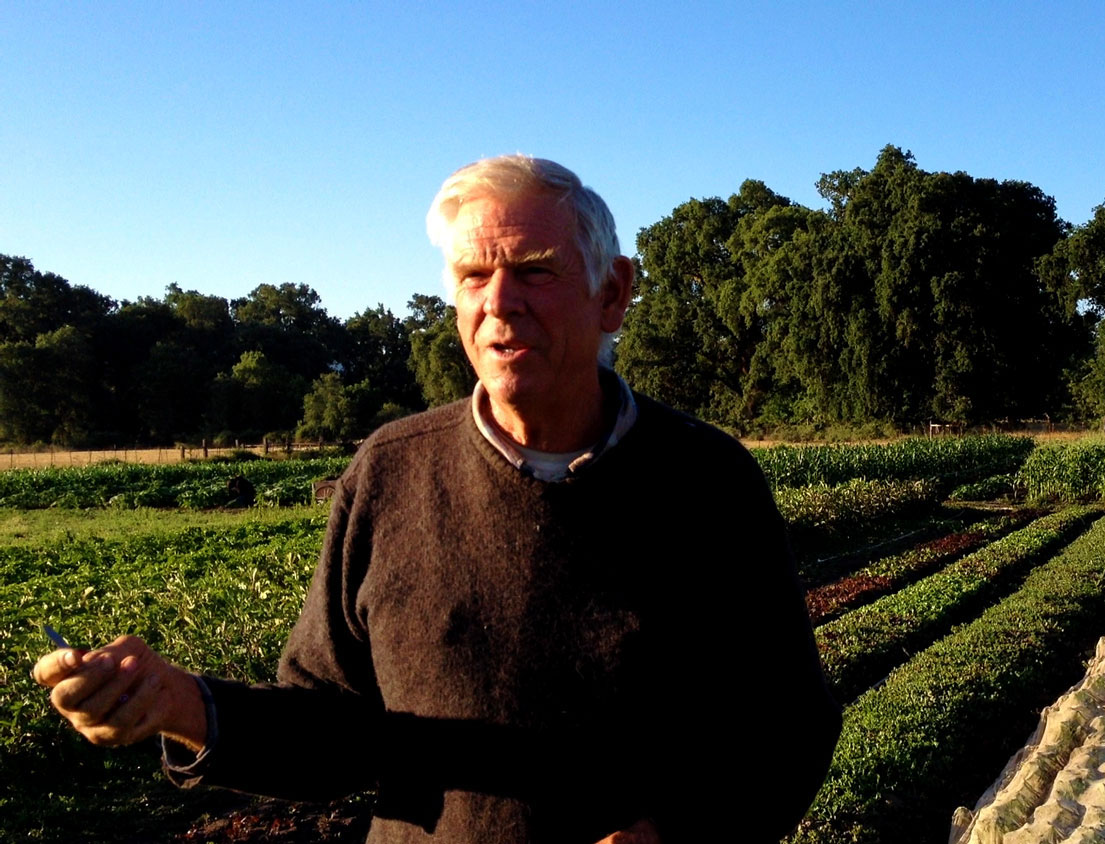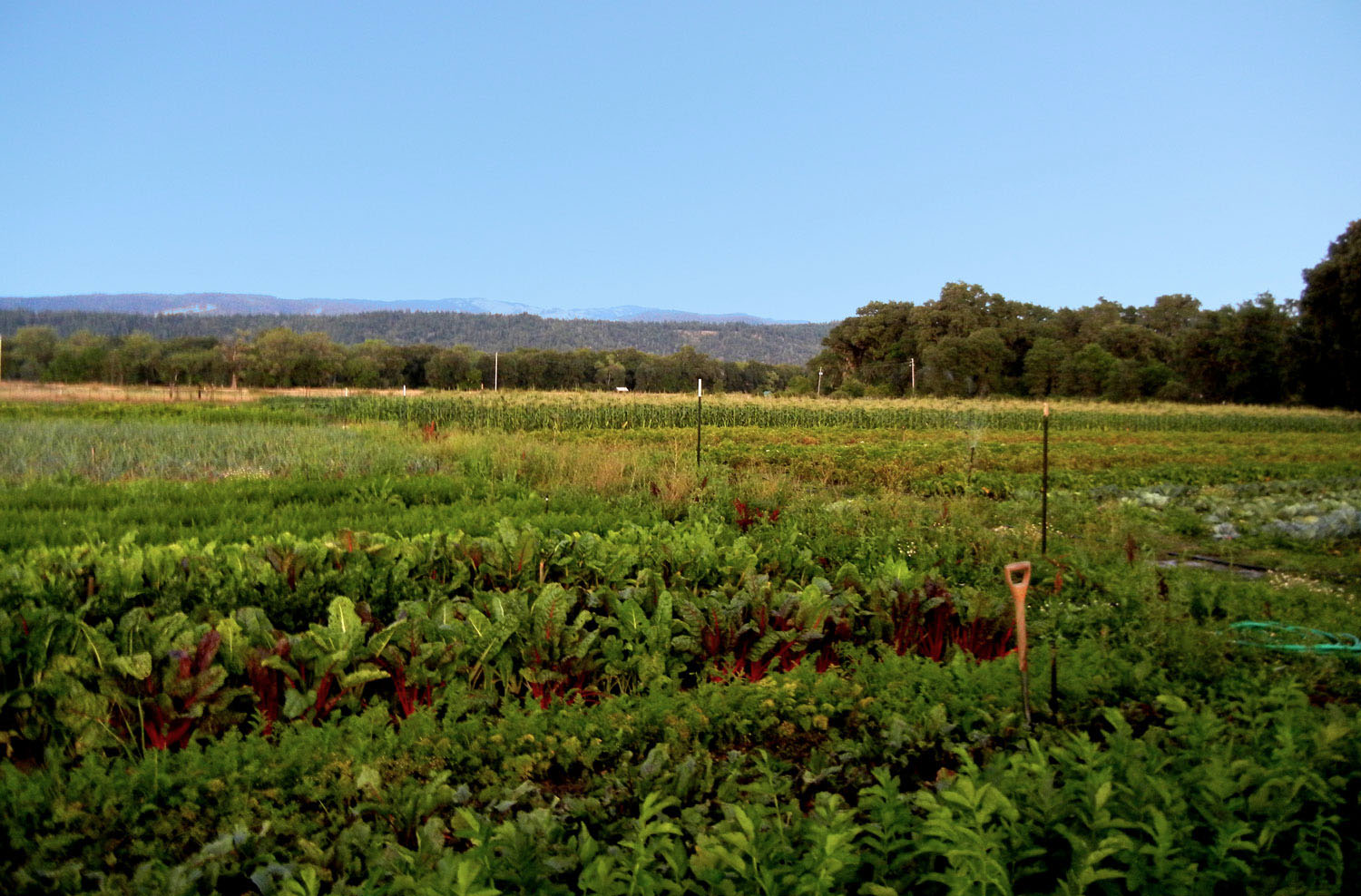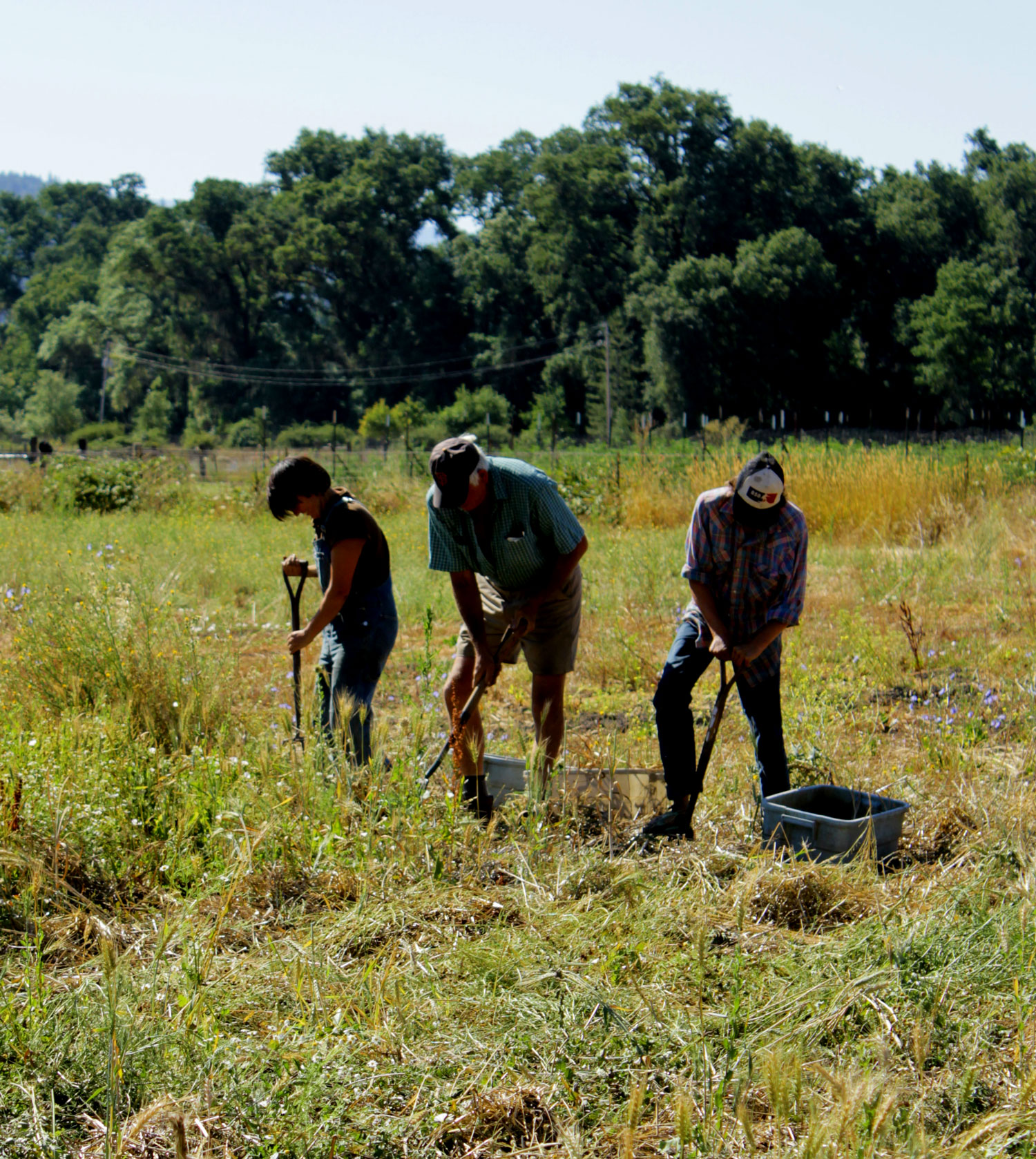Garden Project Milestones
In 1967, when Alan Chadwick first started the hillside garden at the University of California at Santa Cruz, that original horticultural endeavor was called “The Student Garden Project.” Eventually the name was shortened to just “The Garden Project,” particularly after Chadwick moved on to other places. The name stuck, and now refers more broadly to all of Alan’s educational activities in the USA, beginning with Santa Cruz and ending with his death at Green Gulch thirteen years later. Certain recent events that significantly intersect with those historic days of the garden, or with the various individuals involved, will continue to be highlighted here as they come to our attention.
A Salute to Paul Lee on his 90th Birthday
On September 20, 2021, Paul Lee celebrated his 90th Birthday. For those who do not know him, Paul was the primary impresario working behind the scenes to facilitate the Garden Project at UC Santa Cruz.In the spring of 1966 Donald Nicholl, a visiting history professor from England, spoke about “A Sense of Place,” a theme derived from the elderly Welsh poet, David Jones, who was 70 at the time. Professor Nicholl extolled the cultivation of gardens as a fundamental way of creating an essential sense of place in our increasingly chaotic world. Paul Lee, who was present at this talk, was deeply affected by that thought. Creating such an uplifting and unifying sense of place could counteract the disturbing effects of worldwide confusion and the local disruption of campus construction that was reshaping the redwood forest into roads, buildings, and parking lots. The Regents of the University of California had ordained the Santa Cruz campus to ultimately accommodate 27,500 students, and Paul shuddered at the thought of such a major institutional impact on the landscape.
When the next school year commenced after Donald Nicholl’s talk, Paul was inspired to explore the possibility of creating such a student garden on the Santa Cruz campus. He pitched the idea to the University Chancellor, Dean McHenry, and received a surprisingly warm response. The first question was, “Where should the garden be located?” Paul took the initiative and organized a walkabout through the campus searching for a suitable site, with Dean McHenry actively participating.
In that same time frame, a German countess, Freya von Moltke, was residing at the University as the companion to Eugen Rosenstock-Huessy, a visiting professor who had been the mentor of Page Smith, then provost of Cowell College. Freya heard about Paul’s idea for a garden and suggested that her friend, Alan Chadwick, would be the ideal person to lead such an effort. Alan, she said, was currently in route to San Francisco on a ship from New Zealand, and would be visiting her in Santa Cruz soon thereafter.
Photo: Paul Lee carrying his daughter, Jessica, in February 1967, on the day that he, chancellor Dean McHenry, and forty or fifty others walked the campus in search of a suitable garden site.
When Alan arrived, Freya enthusiastically presented the proposed concept of a campus garden to him and urged him to take it on. He was reluctant to do so because of a keen mistrust of bureaucracies, especially of an academic kind. But Freya impressed upon him the vital need for the youth of the world to discover the wisdom of nature and gardening as a healing force. Gradually Alan relented and agreed to meet with Paul Lee to discuss the details. That auspicious meeting between Paul and Alan took place at the Cowell College fountain. Paul described his idea for a student garden, but only in simple general terms.
"I wasn’t interested in gardening; as a typical academic, I was interested in the idea of gardening. I thought it would be a good project for the students on the campus of a university that had been a great ranch landscape—the Cowell Ranch—with vistas looking out from the redwood groves to Monterey Bay and the Pacific Ocean. The students could do the work. I would watch and oversee and enjoy the asters and the poppies when they bloomed."
Alan, however, as an accomplished master of gardening on a grand scale, immediately envisioned the potential in light of his enormous experience in celebrated settings like the British Admiralty Gardens of South Africa. His acute artistic imagination began to fully picture the compelling possibilities. He had the gift of viewing any landscape and envisioning it transformed into a bountiful garden. Paul asked Alan if he would lead the effort. Alan, inspired by the prospect, declared that yes he would be willing to do so. Paul, in his infinite optimism, assumed that the details would work themselves out as the project got going. Alan was of a similar frame of mind. His life experience confirmed that whenever a bold idea aligns with destiny, then the universe will furnish whatsoever is essential for its fulfillment.
At first, Paul was not fully aware that once Alan made a commitment, he would move heaven and earth to achieve his goals. The next day Alan bought a garden spade, made a quick survey of potential garden sites near Cowell College, and began work on one that had the highest horticultural potential, optimal setting and prominent visibility. Paul had a lot of explaining to do, since the campus architect was not pleased by the unauthorized decision made outside of official channels. Paul’s philosophy was, “anarchists don't ask permission.” An alternative formulation of this principle is sometimes heard: It’s better to beg for forgiveness than to ask for permission and risk denial.
Eventually the campus architect was placated, allowances were made, and the Garden Project was born.
Alan commenced to clear away poison oak and brush, layout paths, and dig the first garden beds. Paul began earnestly to speak about the new project in his philosophy classes, ultimately recruiting the first students to participate in the arduous groundwork. John Powell, Phil Amour, and Michael Stusser were among the early apprentices, but others soon followed. Stephen Decater, Alan’s most steadfast apprentice over many years, first heard about the Garden Project in one of Paul Lee’s classes.
In the early spontaneity of creating the garden, neither Paul nor Alan had given thought to the practical aspects of Alan’s basic necessities. Soon, however, Alan began to ask where he should live while working on the garden, and how his basic living expenses would be provided? Paul scrambled, and finally got authorization for Alan to occupy a faculty apartment at Cowell College, and secured a small stipend to cover his expens
es. Whenever issues arose (and there were many) Paul jumped into the breach to solve each problem. Alan had many of the classic attributes of the temperamental artist, and he expected his patron (in this case, the University) to meet his reasonable demands for tools, seeds, irrigation water, deer fencing, a modest greenhouse, etc. Each of these expenses sent the administrators into a conundrum, since no money had been budgeted for the new garden project.
Since Paul had been the one to actually recruit Alan, Alan expected that it was Paul’s responsibility to advocate for the needs of the Garden Project to the University administration. Thus Paul was constantly called upon to work his magic. When there were delays or problems, Alan likewise vented his frustrations on Paul. It was a heroic role that Paul Lee played in the early days of a project that would eventually transform agriculture in California and the rest of the United States.
Before Chadwick, organic gardening was talked about and practiced in limited circles, but its implementation was primitive. Chadwick was the first to show that, practiced rightly, organic gardening and farming could produce better, more beautiful, more nutritious, and more pest-resistant vegetables than conventional chemical-based agriculture. Science and agronomy professors both at Santa Cruz and at UC Davis, the academic hub of the agrochemical industry, were outraged that an organic garden had been established at the UCSC campus. Serious efforts were made to close down the project, and there again, Paul Lee was on the front lines to defend it. Paul’s efforts in establishing Chadwick and the organic gardening project at UCSC were no doubt a significant factor in his subsequent denial of tenure at the University. Agricultural science at the University of California had been securely in the pockets of the agricultural chemical interests for many years. Paul Lee was rocking the boat and so had to be banished.
During his time at UCSC, Paul occasionally took an active role in the garden. In one class project, Paul and his students built a stone retaining wall with terraces at the lower part of the garden where it faces Stevenson College. The Building and Grounds Department at the University complained that Paul’s project had been done without proper engineering design, but that wall has stood for over fifty years without any problems, and it still stands today.
Another time that Paul came to the rescue was when Alan had been deprived of his position and salary at UCSC, largely as a puntative reaction to his emphasis on organic methods. Alan had nowhere to go, and so began to sleep on the floor of the garden Chalet. Out of his own pocket, Paul arranged to have a bathroom added to that building so that the situation would be somewhat more tolerable for Alan.
When the relationship with the University finally colapsed, Paul Lee was instrumental in finding Alan another place to continue his personal crusade on behalf of an ecologically sustainable agriculture. The San Francisco Zen Center had recently acquired 70 acres in nearby Marin County, and through his friendship with its leader, Richard Baker, Paul was able to secure a place for Chadwick and his apprentices to continue their work.
Paul’s many contributions have been overlooked in the general history of the Garden and Farm in publications by the UC Santa Cruz Administration, but they have not been forgotten. Many people over the years helped advance Chadwick’s vision for an ecological agriculture, and Alan could not have achieved his vision without their help. But the contributions of Paul Lee are among the foremost and deserve to be acknowledged by the larger community. On this occasion of his 90th birthday, we offer our immense gratitude for all that he did to help Alan Chadwick in his efforts to firmly establish organic farming methods in the American cultural landscape.
In Memoriam: Gregory Hudson
Sadly, we must report the death of Gregory Hudson, who was one of Alan Chadwick’s principal lieutenants during the Santa Cruz years in the heydays of the campus Garden Project. Greg also worked closely with those of us at the Saratoga Garden for six months from November 1972 into 1973, and also rejoined Chadwick in the early months of the Covelo project, before following his life path of becoming a Waldorf teacher. He was a thoughtful, sensitive and artistic soul who walked humbly on the earth and helped many people to achieve their most worthwhile aims in life.A memorial tribute, posted by his family and friends, is reprinted here:
Gregory's obituary
Gregory was born in Los Angeles on October 18, 1947. His childhood and youth were filled with the trials and inspirations of a big family and a vibrant life in southern California. When he graduated from high school and approached adulthood, he headed to Santa Cruz.In May of 1969, during his junior year of college, Gregory joined the garden project at the University of California at Santa Cruz led by Alan Chadwick. Soon after graduation, Chadwick asked him to join the staff and become one of the assistant gardeners. Their work in food systems and growing methods heavily inspired biodynamics and organics in the west, influenced Alice Waters and California cuisine, and wine makers Fetzer and Frey.
It turns out that the art of gardening was only a fraction of the wisdom and inspiration Alan Chadwick imparted; his exuberance for the world and its mysteries was contagious. For years, Gregory watched and learned from a man who was a Shakespearean actor, master gardener, chef, and philosopher.Gregory left his years with Alan Chadwick and became a master Waldorf teacher, extraordinary chef, intrepid gardener, charismatic actor, fabulous dancer, passionate musician, dapper dresser, brother, uncle, husband, father, and friend.
Gregory often said that he thought of Mr. Chadwick every day.He worked with Chadwick at UCSC, Saratoga, and Covelo and admired each of them, but his love for the garden at UCSC remained the strongest. Knowing this, we are grateful to come together to create a memorial that honors Gregory at the Chadwick Garden on the UC Santa Cruz campus. A row of rare and beautiful heirloom roses and a row of heirloom apples will be planted for Greg and commemorated with a bronze plaque honoring him as a founding apprentice, assistant to Alan Chadwick, and all that he became to us in the years that followed.
The memorial to honor Greg’s memory was held September 18, 2021, on the Chalet deck at the Alan Chadwick Garden at UCSC. Altogether 35 people attended, most in person but with a few viewing remotely. Mardi Sicular and Greg Haynes, who were colleagues of Greg’s from the Garden Project days, came to pay tribute to the profound life experiences that were cultivated at that venerable site, while many of the others were connected to Greg through his work of 30 years as a Waldorf teacher. Many of us like Greg were first introduced to the teachings of Rudolf Steiner by Alan Chadwick at Santa Cruz and inspired by Francis Edmunds, founder of Emerson College in England, during his 1971 visit to Chadwick’s garden.
Former students of Greg spoke appreciatively about the thoughtful commitment that exemplified his teaching. Many parents of his students confirmed these sentiments, gratefully relating kindhearted examples of his astute and loving attention to their children. Colleagues on the teaching staff of the Davis Waldorf School, where Greg spent most of his teaching career, described his many outstanding contributions to the development of the school. It was abundantly apparent that Greg was a dearly loved member of his community. May he rest in peace.
Photo Notes:
The black and white photo at the top of this page was taken by Eric Thiermann in 1967 during the expedition organized by Paul Lee to find a suitable garden site at UCSC. The two color photos here were taken by Michael Stusser. They are still-frames from his 1971 film, Garden. In this photo, Greg Hudson stands on the left, with Paul Lee standing on the right.
Contributed by Greg Haynes, October 2021
Stephen Decater in the farm fields at Live Power Community Farm 2012
In Memoriam: Stephen Decater
Stephen Decater died at Covelo, California, on November 4, 2021. He was undoubtedly the most steadfast of Alan Chadwick’s apprentices, playing an essential role in the development of both the Santa Cruz and Covelo gardens. Steve was also, in many ways, Alan’s spiritual successor. He deeply valued the gifts that Chadwick had magnanimously bestowed on the world, and he endeavored, in his own way, to keep Alan’s message alive. In addition to maintaining his bountiful demonstration garden in Covelo where, over the years, he trained generations of apprentices, he also hosted many groups of school children who came with their teachers to learn how food is produced and how farmers participate in that miracle.
Steve was a worthy example of how human beings can live and work in the world in such a way that the ecological health of the planet is improved through their presence. His humility was an important feature of his character and one that stands in marked contrast to the typical ways of the world. He once told me that the basis for all meaningful action is a sense of gratitude for all that life sends us, whether easy or difficult. He believed that by maintaining a sincere sense of gratitude, we attract the spiritual blessings of the invisible powers. It is a mysterious kind of magic that can mean the difference between a wasted life and one that magnifies the bounties of nature and shares them with humanity.
One of the reasons that Steve could be so effective in his work is that he had the physical and spiritual support of his loving wife, Gloria, who shares much of the credit for all that was accomplished at Live Power Community Farm. We must also acknowledge the contributions of Richard Wilson who had the foresight to recognize the potential within Steve Decater and to help him get established on his farm at Covelo.
On behalf of the wider Chadwick community we express our sincere regret at the passing of Stephen Decater and offer our condolences to his friends and family. We can only content ourselves with the knowledge that our deceased friend and co-worker, by right, has earned the encomium: "Well done, Thou good and faithful servant."
Greg Haynes
July, 2022
In this four-part video interview conducted in 2012, Steve tells the story of how he came to work with Alan Chadwick at Santa Cruz, and what that experience meant to him throughout the course of his life.
Steve and Gloria conduct a guided tour of their farm in Covelo in this video recorded by the Biodynamic Association of Northern California. Note: Click the "video" tab at the top of this page, then scroll down to the video entitled: A Tour of Live Power Farm with Stephen and Gloria Decater.
The Newletter of the Biodynamic Association of Northern California has included numerous tributes to Steve Decater and his work.
Vegetable beds at :Live Power Community Farm, Covelo, California 2012
Steve Decater had a giant heart and passion for farming and inspired hundreds of young aspiring farmers with his dedication. I knew Steve through the Biodynamic Association of Northern California and visited his and Gloria's epic Live Power Farm in Covelo many times. We did a photo shoot for a Real Goods catalog cover a decade ago while he was plowing with one of his horses and I sold him some PV modules to help in his quest toward energy independence. Whenever I encountered Steve he was full of positive energy and grace and knew how to listen as well as talk. He always impressed me with his impeccable integrity and honesty. He came down to our SolFests at the Solar Living Center in Hopland and spoke selflessly several times and never asked for a penny for his services. He inspired hundreds of seeking souls on those occasions and never ceased to impress anyone with whom he had contact. Steve was a true Mensch in every sense of the word and the regenerative ag movement as well as the world were lucky to have him during his stay on the planet. He will not be forgotten.
John Schaeffer, Hopland, California
Steve Decater with apprentices at Live Power Community Farm 2012
Recollections of Stephen Decater
I found my way into the Santa Cruz garden sometime in early March of 1971. Beside the seven or eight apprentices who were active at that time, there were three staff members who acted as Alan’s lieutenants. One of these was Steve Decater.
I had few interactions with Steve in those early days because he moved in loftier realms than I did. While I would be assigned to whatever the most urgent project of the day might be, Steve had responsibilities for specific areas and he tended to keep his focus on those. During the construction of the second herbaceous border, for example, my job was to work with the crew that was gathering stones from the quarry on the lower campus and transporting them up to the garden for paving the path. Steve, however, was given the responsibility for designing the layout of the perennial plants that would make up the border.
This was both highly artistic and highly technical. I remember seeing the plans that Steve had prepared: a long sheet of vellum with the herbaceous boarder drawn at a large scale, maybe 1 inch equals 1 foot. The exact placement of each plant was drawn and labeled. Delphiniums here, columbine there. Anchusa Italica Dropmore here, Inula helenium there. Low growing plants in front, medium in the middle, and tall in the back. The essential thing was to insure that the border would be in bloom all year long and that the blooming plants were well distributed so that it would always appear that the whole border was in bloom.
In those days, Alan had designated Friday mornings as a time of quiet and contemplation in the garden. No one was allowed to talk during that period because that would disturb the meditative mood that was encouraged by Alan. He had described the three steps required for entry into a level of consciousness that transcended the merely mundane: 1. Concentro, 2. Meditato, 3. Contemplo. We apprentices were encouraged to set aside the shallow chatter that usually accompanied our labors and to work deliberately, focused and observant of the subtle details that often went unnoticed.
It was on one of those Friday mornings that I got to know Steve Decater a little better. At the morning meeting, Alan had asked Steve if he would plant vegetable marrow in the area directly below the path leading into the main garden. Steve had agreed to manage that task, and when Alan asked if anyone would be willing to work with Steve on that project, I volunteered.
After the meeting broke up, I meekly followed Steve over to where we would be working. Steve then proceeded to give me instructions about what we needed for tools and materials, but because he couldn’t speak (this being the day of quiet and contemplation) he employed pantomime to communicate his intentions. Evidently he found this amusing because I witnessed his smile for the first time. He had always seemed so serious to me that I was surprised to discover that he had a sense of humor.
The process was somewhat complex. First we pounded a series of wooden stakes into the steep hillside that would support a wooden plank about 14” high and about 6’ long. That plank would keep our planting area from sliding down the hill. Behind it we cultivated the soil a good 12” deep, stratifying it with layers of compost, bone meal, and cow manure, eventually bringing the level of the soil up to the top of the plank. When everything was ready, we sowed the seed of the marrow, which is a kind of heirloom zucchini.
In my mind, I can still see the wry smile with which Steve acted out the charade that was necessary to tell me what he needed. I found the whole project extremely funny, and we both thoroughly enjoyed the morning. By the time lunch was announced we had finished our work and the ban on talking was lifted.
Until I got to know him better, Steve was something of an enigma to me. He made absolutely no attempt to show off his knowledge or superior status. Typically, young men will compete for status in the social pecking order, but Steve always seemed to be above all that. At first I thought something was wrong with him, that he might be a little bit mentally deficient perhaps. Later I came to see that his sense of self-esteem was derived from within and that he had no need to engage in the usual jockeying for dominance that is so prevalent among men.
He was a man of few words, though when he did speak it behooved you to listen. He was not diffident in the slightest bit. It was the quiet confidence that one might have seen in the Buddha, for example. For most of us, probably 90% of what we say is vanity. Steve just edited that part out of his speech.
For thirteen years, between 1967 and 1980, Alan Chadwick set an example of selfless service to humanity. Steve Decater followed that example for the rest of his life and he was probably the only one of Alan’s apprentices to do so.
Greg Haynes, July, 2022
Stephen Decater at the farm in 2012
Vegetable beds in the morning at Live Power Community Farm 2012
In Memoriam: Paul Lee
No matter how advanced in age, the death of a colleague, friend or mentor invariably occasions a deep and inwardly personal sense of loss.
Paul Lee departed this world at age 91 on October 20, 2022 in Santa Cruz, California. As a philosopher and theologian, he had, no doubt, reconciled himself to the end of his physical existence. And being a religious man, he probably saw death as a momentous transition to another and higher plane. I visited Paul Lee in Santa Cruz several times over the last few years and last spoke with him as he reached the venerable age of 90. He retained his jovial sense of humor while still pursuing his lifelong philosophical research. May his onward journeys be even more fulfilling.
Paul will always be remembered on these pages as the one who persuaded Alan Chadwick to start his legendary garden at the University of California at Santa Cruz. He was a major catalyst of that auspicious and memorable legacy and remained a loyal friend of Alan Chadwick’s to the end.
Looking back, Paul was not without his foibles―as is true for each of us―but he rose to the occasion when destiny required it. He was always ready to play his part when something essential was at stake, like finding a new location for Chadwick at Green Gulch or Covelo. And on those occasions he instinctively placed himself in the service of higher powers. Paul’s abundant and gregarious contacts with influential people like Richard Baker, Huey Johnson, and Richard Wilson played a decisive role in the evolution of the Chadwick gardens. That extensive networking talent fortuitously synchronized with over-overarching and loftier purposes in life. It was a symbiosis that functioned on both the mundane and higher planes.
This critical role was performed despite several severe trials that Paul had to face in the course of his life. Not the least of these was the denial of his tenure at the university and termination of his faculty position due to his advocacy of Alan Chadwick and the organic garden project at UCSC. Both Paul and Alan were ahead of their time, and both their fates bear out the prescient saying of Voltair:
"It is dangerous to be right in matters on which the established authorities are wrong."
But, on a higher level, the anguish that results from self-sacrifice in service of the good is a distinction that grants entry into the company of a select and chosen few who find true fulfillment in a deeper transcendent connection with life and creation.
Paul, thank you for all your many contributions and service to a renewed vitalism and idealistic vision of life. Thank you for a host of colorful memories interwoven with the inspirational heritage of Alan Chadwick and his gardens. Bon voyage. You will be missed.
(See the top of this page for a tribute we made to Paul on the occasion of his 90th birthday)
―Contributed March 13, 2023 by Greg Haynes
Return to the top of this page

